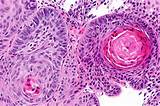Esophageal cancer pathophysiology
|
Esophageal cancer Microchapters |
|
Diagnosis |
|---|
|
Treatment |
|
Case Studies |
|
Esophageal cancer pathophysiology On the Web |
|
American Roentgen Ray Society Images of Esophageal cancer pathophysiology |
|
Risk calculators and risk factors for Esophageal cancer pathophysiology |
Editor-In-Chief: C. Michael Gibson, M.S., M.D. [1] Associate Editor(s)-in-Chief: Hadeel Maksoud M.D.[2]
Overview
The pathophysiology of esophageal cancer depends on the histological subtype.
Pathophysiology
The esophagus is lined by nonkeratinized stratified squamous epithelium. This lining is maintained as long as there are no stressors leading to a metaplastic change. These stressors may include genetic factors, chronic alcoholism, smoking, ingesting spicy foods and hot liquids frequently, and chronic gastroesophageal reflux. Eventually, a dysplastic change occurs followed by a metaplastic change, which may be squamous cell carcinoma or adenocarcinoma.[1]
Pathology
Gross pathology
Squamous cell carcinoma or adenocarcinoma of the esophagus may appear as:[2]
- Flat and irregular plaque
- Polypoid lesion
- Ulcerating, fungating mass.
- Location:
- Squamous cell carcinoma is usually found in the mid-third of the esophagus.
- Adenocarcinoma is usually found in the lower third of the esophagus near the gastric opening.
- Location:
Microscopic pathology
Nuclear atypia of malignancy:
- Found in both types:
Squamous cell carcinoma:
- Atypical squamous cells invade the basement membrane [3]
- Cytology of squamous cells:
- Eccentric nucleus
- High mitotic activity
- Eosinophilic cytoplasm
- Squamous whorls or keratin pearls
- Cytology of squamous cells:

Adenocarcinoma
- Atypical adenomatous cells show:
- Invading cell clusters or glands[4]
- Cribriforming
- Desmoplasia
- Invasion into submucosa

References
- ↑ Quante M, Graham TA, Jansen M (2017). "Insights into the Pathophysiology of Esophageal Adenocarcinoma". Gastroenterology. doi:10.1053/j.gastro.2017.09.046. PMID 29037468.
- ↑ Sugarbaker, David (2015). Adult chest surgery. New York: McGraw-Hill Education. ISBN 0071781897.
- ↑ "Squamous cell carcinoma of the esophagus".
- ↑ "Esophageal adenocarcinoma".